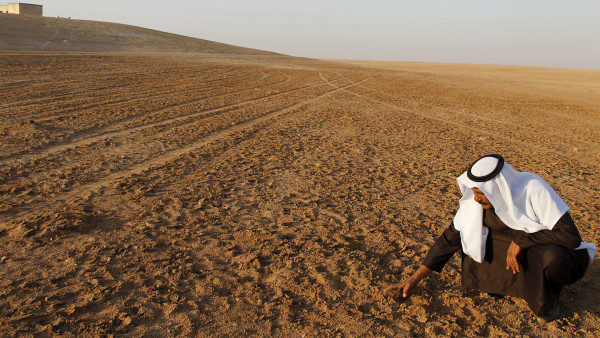PHOTO: Sheikh Ghazi Rashad Hrimis inspects a parched field in Raqqa Province, November 2010 (Khaled al-Hariri/Reuters/Corbis)
Peter Schwartzstein writes for Foreign Policy:
On July 15, 2012, Mahmoud Solh at the International Center for Agricultural Research in the Dry Areas (ICARDA) received the news he’d long been dreading: Syrian rebel fighters had drawn too close to the center’s headquarters near Aleppo for the board of trustees’ comfort. As the director-general of an organization with 600 employees and a net expenditure of $71 million in 2014, he was going to have to shut most operations down.
The uprooting of the Middle East’s largest agricultural organization was an ominous early warning of the chaos that has since engulfed most of Syria. But it did not come as much of a surprise to the employees at ICARDA’s sprawling 2,500-acre research station in the village of Tel Hadya. As members of an organization charged with boosting food security in Syria, they knew that one of the underlying causes of the conflict — the poor agricultural conditions that fueled popular discontent across the country — was not getting any better. For years, they had witnessed the hardship of Syrian villagers up close, as extended bouts of low rainfall cut crop yields and pushed farmers off their land, which ultimately led some of them to take up arms….
There is plenty of tragedy, but also some irony, in ICARDA’s forced departure from Syria. The reason the organization was based there in the first place was in large part because Hafez al-Assad, the country’s longtime dictator and father to Bashar, hoped it would prevent a catastrophic drought of the sort that is now fueling the country’s ongoing war….
the organization did assist Syria in earning a reputation, until recently, as the region’s agricultural powerhouse. For more than a decade, the country was self-sufficient in cereals and had been exporting wheat to Jordan and Egypt. To many neighboring states, which regularly spend large sums of money to buy foreign foodstuffs, Syria seemed the picture of agricultural health.
But all wasn’t well, and the measures taken to turn Syria into an agricultural power in the first place had a lot to do with this. The government sponsored the expansion of farmland, which grew from about 1.5 million acres in the mid-1980s to roughly 3 million acres by 2000. It also almost doubled the number of wells, which contributed to a rapidly falling water table. At the Tel Hadya station, ICARDA recorded a 40-meter drop in local water levels between 1984 and 2010. When the rains failed starting in 2006, farmers turned to groundwater for supplemental irrigation as they had during past droughts — but found that many of the wells had run dry or turned saline.
The Syrian government wasn’t blind to the perils of fast-depleting aquifers and moved to tackle the overuse of well water. But some of its solutions, while likely necessary from a purely environmental perspective, only contributed to rural hardship. In May 2008, authorities in Damascus dramatically cut diesel subsidies, raising the price of fuel from 7 Syrian pounds ($0.14) per liter to 25 pounds ($0.53) overnight. For many farmers, whose income had already tanked with reduced yields, the heightened cost of operating their pumps and transporting their goods to market was the final straw.
“Everything from the weather to the government was bad, but after the oil price [increase], we just gave up,” said Ahmed Talib, a former farmer from the town of Binnish, which is about 5 miles from the ICARDA station….

